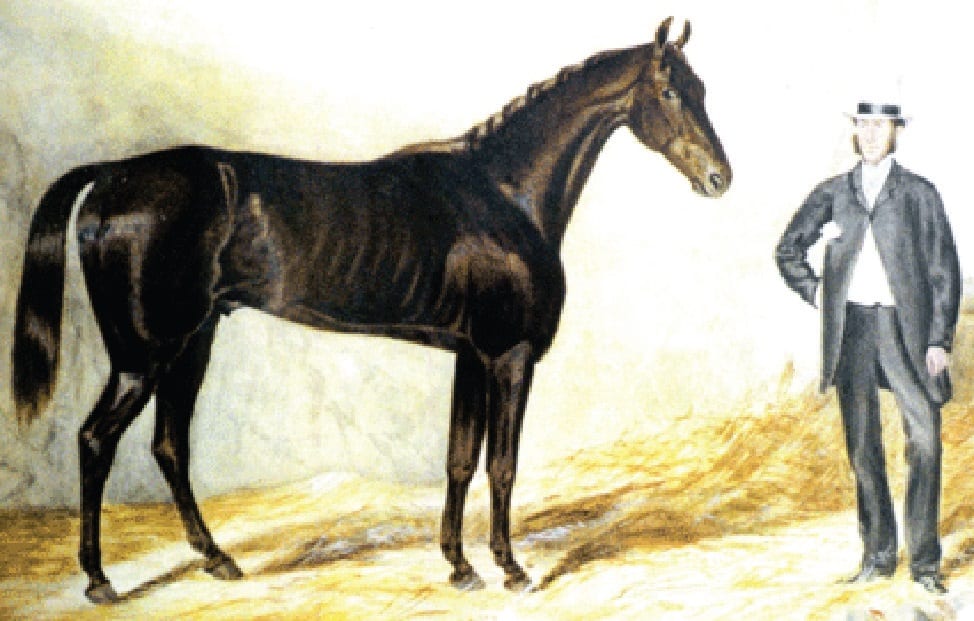Tags: History. Melbourne Cup. Horse racing events. Australia.
The running of 2018 Melbourne Cup was fast approaching and whilst punters around the country, and for that matter, around the world was already considering which of the horses would have the best chance of being first past the post, very few people will take the time to think about the history of the race or the story of the horse that came home first in the first Melbourne Cup on November 7th, 1861.
Featured Image(above): Archer with owner TJ Roberts in 1862 – Painted by Frederick Woodhouse Snr – Image courtesy of Mrs Olive Royds
The Melbourne Cup is famous as the most prestigious Thoroughbred horse race in Australia and is an event which is run as part of the Melbourne Spring Racing Carnival. Referred to as “the race that stops the nation,” it is the richest “twomile” handicap in the world and among the richest turf races.
The event was initially run over 3.219 kilometres and that remained the distance for the race until 1972 when it was shortened to 3,200 metres (1.988 miles) after Australia converted to the metric system. The inaugural race, consisting of seventeen starters and watched by a crowd of about four thousand, was a rather eventful affair with one horse bolting prior to the start and another three falling during the race, two of which being injured to the extent where they had to be put down.
Contrary to the beliefs of some, the prize was not the richest purse up to that time and the winner received 750 gold sovereigns and a hand-beaten gold watch. The first Melbourne Cup Trophy was not presented until 1865 and the first proper Melbourne Cup was awarded to owners of race winner “The Barb” in 1866. A three year old by the name of Archer ensured his place in racing history when he won the first Melbourne Cup in a time of 3 minutes 52 seconds, beating the favourite Mormon by six lengths.
He had also defeated Mormon earlier the same year in the Australia Cup over 2.5 miles at Randwick. Earning the nickname “The Bull” with those who knew of him, Archer was a large horse for a three-year-old, standing over sixteen hands with powerful hindquarters well-sprung ribs and a good head. He was known for his long stride, being able to cover forty-three metres in sixteen strides and his large frame took its toll on his legs, often resulting in him being lame. A noted idiosyncrasy of Archer was that he always galloped with his tongue lolling out of his mouth.
Archer was foaled in 1856 in New South Wales and there are conflicting reports about where this took place. Whilst there are some who believe that he was foaled at Exeter Farm near Braidwood, there is also evidence to suggest that Thomas Royd’s Ballabala cattle farm was the correct location. Royd was the owner of both the sire, William Tell, and dam Maid of the Oaks of the future champion. Owned by Tom Roberts, in 1860 Archer was leased by Etienne de Mestre of Terara near Nowra and his training commenced the same year.

In the lead up to his success in the 1861 Melbourne Cup, Archer had won the Randwick Plate in both 1860 and ’61, the Steward’s Purse in 1860, the Australia Plate and the Maitland Town Plate in 1861 and, the day after his Melbourne Cup win, ran first in the Melbourne Town Plate. In 1862, and ridden once again by jockey John Cutts, Archer won the second Melbourne Cup by eight lengths in a time of 3 minutes 47 seconds, starting as the favourite at 2 to 1 odds in front of a crowd which was almost double the size of the previous year’s spectators.
Winning the prestigious race twice in two years was a feat which was not equalled until Peter Pan won back to back Melbourne Cups more than seventy years later. There have been many outstanding performances in “the race that stops the nation” since Archer’s 1861 and ’62 victories but as well as being the very first winner, Archer will be remembered as one of only two horses that have won the race by eight lengths with Rain Lover equalling that performance in 1968. As a fitting tribute to “The Bull”, he was inducted into the Australian Racing Hall of Fame in 2017.
Other Articles
